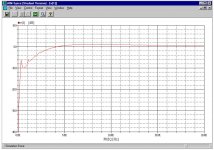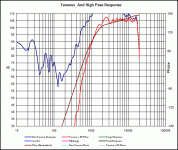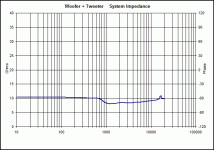one day you want to sell the kit as a 4PiSpeaker (passive loudspeaker).
Haha, I hope that this day will not be too early
Probably I can get a pair of eminence H290 horns in a belgian store. Same price as the H290S horns of Wayne P., but without huge shipping costs.
I think I'll buy these horns, as the original 4pi design had these horns too. Besides, I like more the look of the eminence horns then the shiny look of the H290S horns. But that is negligible for the audio quality off course
I guess there is not a huge difference between the 2 types of horn. (I have normal ears. Not super-hifi-sensitive
Well, it's not a finished setup, just the current config of something I'm working on, but I can explain why. I was trying to design a passive crossover, but could not get good phase tracking at as low of a crossover point as I wanted. Eventually I gave up, and decided to insert an active crossover just to be able to delay the woofer a little. While simulating that, it occurred to me to use the LR4 part of the active crossover in combination with passive parts to try out extreme slopes. I did that, and it worked okay.
Then, back in simulation, I realized that by happy accident the active LR4 by itself actually happened to bring the drivers into phase in the region I wanted the crossover, with no additional delay. So, on the HF I added passive compensation for the waveguide response tilt, and a broad passive notch filter (which is just helpful for this specific waveguide+driver combination to flatten a hump in the bottom octave of the waveguide response and flatten impedance a bit). And, that's how it sits at the moment.
Then, back in simulation, I realized that by happy accident the active LR4 by itself actually happened to bring the drivers into phase in the region I wanted the crossover, with no additional delay. So, on the HF I added passive compensation for the waveguide response tilt, and a broad passive notch filter (which is just helpful for this specific waveguide+driver combination to flatten a hump in the bottom octave of the waveguide response and flatten impedance a bit). And, that's how it sits at the moment.
dumptruck,
The problem of the notch filters in horns combos is that you need 3, the one you're using is the first major needed and it's around R. frequency of the driver, the other two are for the higher harmonics. That's why they tend not to be used (1 notch or more) so often in passives, as a bad concept to solve interaction resonances (impedance peaks) between the passive components and the CD drivers, in designing crossovers. There are other ways to have a smooth high pass.
Crossover Electronics 101 - Pi Speakers
The problem of the notch filters in horns combos is that you need 3, the one you're using is the first major needed and it's around R. frequency of the driver, the other two are for the higher harmonics. That's why they tend not to be used (1 notch or more) so often in passives, as a bad concept to solve interaction resonances (impedance peaks) between the passive components and the CD drivers, in designing crossovers. There are other ways to have a smooth high pass.
Crossover Electronics 101 - Pi Speakers
Attachments
Last edited:
I ordered a pair of H290C horns frow Wayne P. I'll go with the 4pi speaker design, because I realised after a lot of reading about pattern control etc. that I don't have sufficient knowledge (and time) to understand the exact physics of speakers.
Understanding the basics is good enough for me
This also means that I'll not buy the SEOS-15 horns (as good as they probably are), because I fear I can never make a good speaker design with perfect position of horn and woofer and BR port.
Now it's waiting for the horns to arrive, but I'll start building the cabinets as I have the plans for a 4pi speaker. Hopefully, the horns arrive soon!
Maybe I'll combine the appearance of the JBL4430 cabinets with the 4pi. (the black front baffle, black speaker cloth, just in front of the woofer. We'll see
Understanding the basics is good enough for me
This also means that I'll not buy the SEOS-15 horns (as good as they probably are), because I fear I can never make a good speaker design with perfect position of horn and woofer and BR port.
Now it's waiting for the horns to arrive, but I'll start building the cabinets as I have the plans for a 4pi speaker. Hopefully, the horns arrive soon!
Maybe I'll combine the appearance of the JBL4430 cabinets with the 4pi. (the black front baffle, black speaker cloth, just in front of the woofer. We'll see
I don't have experience with active crossover, so I don't know what's the best mix between active and passive components, to achieve a good smooth crossover curve and at the same time protecting the tweeter.Well, I have used other ways, but can you explain to me what the problem is with this? It seems okay to me.
That's my only concern: the active x-over instead of the passive x-over.
I couldn't afford a $250 more for the passive cross-overs and, to be honest I'm very happy with the active setup (great damping factor of the woofer, I really hear a difference with passive x-over). Hopefully, Wayne will give me the needed info here.
I couldn't afford a $250 more for the passive cross-overs and, to be honest I'm very happy with the active setup (great damping factor of the woofer, I really hear a difference with passive x-over). Hopefully, Wayne will give me the needed info here.
I have a conventional electronic cross-over. It has no CD-compensation function. But I checked some measurements of the de250 with Wayne's H290C horn, without compensation:
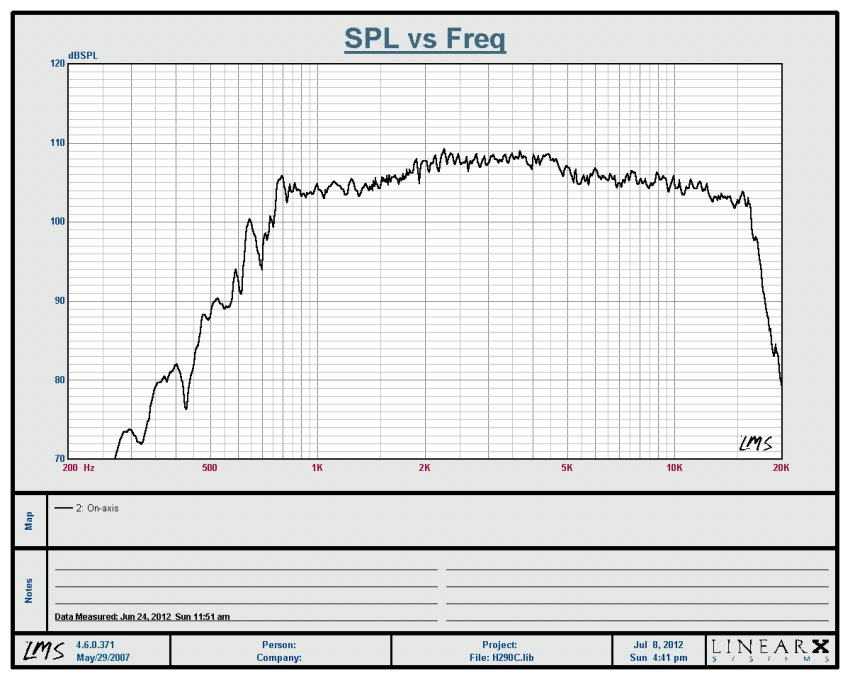
Will there be an audible difference with CD-compensation? The response of the driver-horn combination seems quite good to me, even without compensation!
However, I sent Wayne a mail with the question which passive adjustments are required with active X-over.

Will there be an audible difference with CD-compensation? The response of the driver-horn combination seems quite good to me, even without compensation!
However, I sent Wayne a mail with the question which passive adjustments are required with active X-over.
Last edited:
Yeah, you might want a bit of a downward tilt to the overall system response (I do with this type of speaker), but the uncompensated response is not a great starting point. I think you'd find that to avoid excessive "bright" sound, you would have to turn the HF attenuation down to the point of not really having any upper treble.
Thank you for the explanation, Dumptruck. I read through the forum of Waynes website to understand completely what CD compensation is.
Here I found a good explanation (read Waynes answer):
AudioRoundTable.com: Pi Speakers => Erse caps, attenuation circuits.
Wayne uses a R1/R2/C1 configuration to adjust the frequency response of the HF driver. The specific values he uses for the 4pi speakers:
Pi Speaker Forum - Clarification of attenuation values - Wayne Parham, August 01, 2002 at 12:48:20
This is the schematic of the 4pi passive cross-over design:
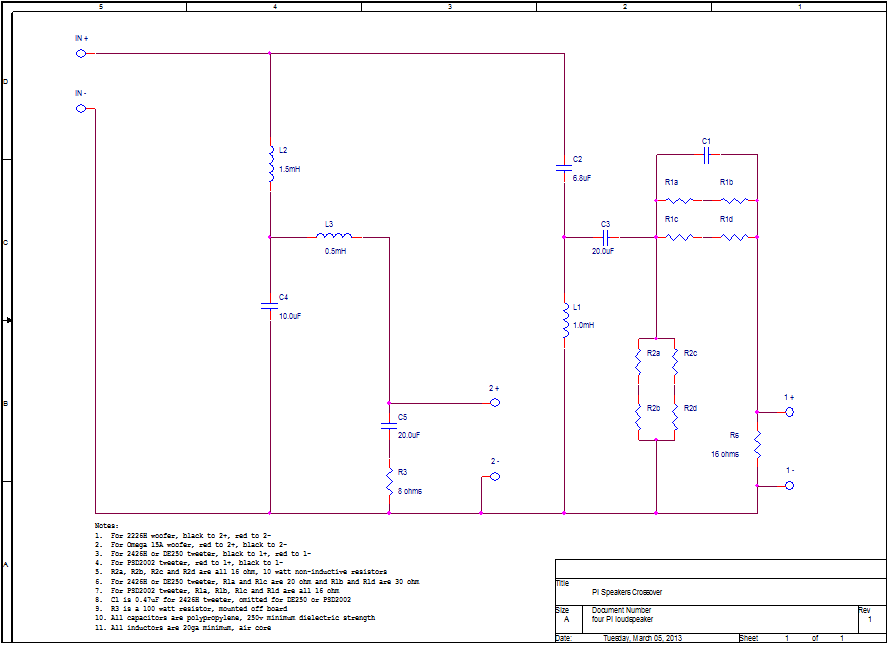
If I'm right, I just have to use use the R1 and R2 for the b&c de250 (C1 can be omitted).
Till here my 'knowledge'. I'm not an engineer, so here is my question to the members of the forum: Can I use the same values for my active setup (same drivers, same h290C horn, same enclosure) for CD compensation. I'd like to obtain a similar top octave compensation response curve as obtained with the passive crossover.
Thank you very much!
Here I found a good explanation (read Waynes answer):
AudioRoundTable.com: Pi Speakers => Erse caps, attenuation circuits.
Wayne uses a R1/R2/C1 configuration to adjust the frequency response of the HF driver. The specific values he uses for the 4pi speakers:
Pi Speaker Forum - Clarification of attenuation values - Wayne Parham, August 01, 2002 at 12:48:20
This is the schematic of the 4pi passive cross-over design:

If I'm right, I just have to use use the R1 and R2 for the b&c de250 (C1 can be omitted).
Till here my 'knowledge'. I'm not an engineer, so here is my question to the members of the forum: Can I use the same values for my active setup (same drivers, same h290C horn, same enclosure) for CD compensation. I'd like to obtain a similar top octave compensation response curve as obtained with the passive crossover.
Thank you very much!
No.If I'm right, I just have to use use the R1 and R2 for the b&c de250 (C1 can be omitted).
Till here my 'knowledge'. I'm not an engineer, so here is my question to the members of the forum: Can I use the same values for my active setup (same drivers, same h290C horn, same enclosure) for CD compensation. I'd like to obtain a similar top octave compensation response curve as obtained with the passive crossover.
Thank you very much!
R1/C1 is the compensation.
I'm sorry, I don't understand at all 
I thought that CD compensation is done by 2 resistors and a capacitator.
The values of the components vary in accordance with the tweeter compensation you want to do. (correct me if I'm wrong)
Here I copied a chart of this configuration, found on Waynes forum:
For 12dB attenuation, I'd need the following values:
R1 = 25 ohm
R2 = 16 ohm
C1 = 0.47uF
But looking at the cross-over for the 4pi speaker, I saw there is a little adjustment in the tweeter compensation configuration for de de250 driver: point 8: C1 is 0,47µF for 2426H tweeter, omitted for de250 and psd2002.

I concluded (please correct me if I'm wrong!) that just R1 and R2 compensate the tweeter response.
However, Wayne mailed me that I wouldn't need a 12dB equalization.
Looking at the following response curve of the de250 on a h290c horn, I think an attenuation of 3dB (or 6dB) before mass rolloff would be ok (active crossover: 1,6khz, so don't look at the lower frequencies)

I hope that you can help me with this
thanks!
I thought that CD compensation is done by 2 resistors and a capacitator.
The values of the components vary in accordance with the tweeter compensation you want to do. (correct me if I'm wrong)
Here I copied a chart of this configuration, found on Waynes forum:
Here's a chart that shows the appropriate values of R1, R2 and C1 compensation components for the Pi crossover. The way it works is the level of attenuation shown in the "dB" column is what the circuit presents to the tweeter below mass rolloff. Above that, attenuation is removed at 6dB/octave. So if you use R1/R2/C1 values that give 10dB attenuation, the tweeter will be -10dB from crossover up to 6kHz, at 12kHz it will be -4dB and by 20kHz there is no attenuation at all.
dB R1 R2 C1
====================================
6dB 12 ohm 30 ohm 0.47uF
8dB 12 ohm 20 ohm 0.47uF
10dB 16 ohm 16 ohm 0.47uF
12dB 25 ohm 16 ohm 0.47uF
14dB 30 ohm 14 ohm 0.33uF
16dB 40 ohm 12 ohm 0.33uF
18dB 50 ohm 12 ohm 0.22uF
20dB 75 ohm 12 ohm 0.22uF
====================================
For 12dB attenuation, I'd need the following values:
R1 = 25 ohm
R2 = 16 ohm
C1 = 0.47uF
But looking at the cross-over for the 4pi speaker, I saw there is a little adjustment in the tweeter compensation configuration for de de250 driver: point 8: C1 is 0,47µF for 2426H tweeter, omitted for de250 and psd2002.

I concluded (please correct me if I'm wrong!) that just R1 and R2 compensate the tweeter response.
However, Wayne mailed me that I wouldn't need a 12dB equalization.
Looking at the following response curve of the de250 on a h290c horn, I think an attenuation of 3dB (or 6dB) before mass rolloff would be ok (active crossover: 1,6khz, so don't look at the lower frequencies)

I hope that you can help me with this
thanks!
I think I'm wrong here.
Wayne mailed me about this, he's extremely helpfull.
(and I understand now what you want to say Inductor )
)
But I'll have to read a lot to find out which components and which values I have to use to compensate the mass rolloff of the tweeter.
If somebody has done this before, don't hesitate to inform me
Wayne mailed me about this, he's extremely helpfull.
(and I understand now what you want to say Inductor
But I'll have to read a lot to find out which components and which values I have to use to compensate the mass rolloff of the tweeter.
If somebody has done this before, don't hesitate to inform me
Not a problem. He's very professional.I think I'm wrong here.
Wayne mailed me about this, he's extremely helpfull.
(and I understand now what you want to say Inductor)
1. Invert polarity for JBL's woofers as Black>+2/Red>-2
2. n.a.
3. DE250 tweeter Black>+1/Red>-1
4. n.a.
5. R2 = 15R/10Wn.i.
6. DE250 tweeter R1a/R1c = 20R/n.i., R1b/R1d = 30R/n.i.
7. C1 is omitted for DE250 tweeter (no compensation)
8.
9.
10.
I translated this (not complicated) for you. Hope this helps. You might not need it by now...
"They attenuate the tweeter response 12dB's."For 12dB attenuation, I'd need the following values:
R1 = 25 ohm
R2 = 16 ohm
C1 = 0.47uF
But looking at the cross-over for the 4pi speaker, I saw there is a little adjustment in the tweeter compensation configuration for de de250 driver: point 8: C1 is 0,47µF for 2426H tweeter, omitted for de250 and psd2002.
I concluded (please correct me if I'm wrong!) that just R1 and R2 compensate the tweeter response.
(ps: we are already repeating ourselves, have a nice time.
Last edited:
- Status
- This old topic is closed. If you want to reopen this topic, contact a moderator using the "Report Post" button.
- Home
- Loudspeakers
- Multi-Way
- Upgrading drivers
